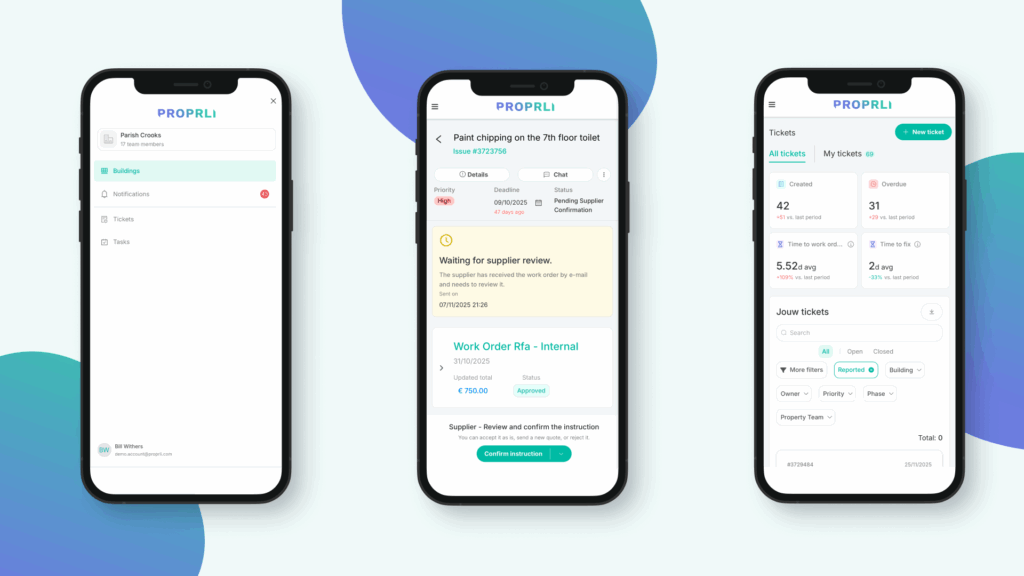The role of the property manager is evolving rapidly. In an era where owners demand transparency, tenants expect service excellence, and regulations are increasingly strict, knowledge of a building can no longer live inside the head of one person. It must be captured digitally, structured clearly, and accessible instantly.
Modern property management is about more than reacting to problems. It’s about making sure every detail of a building’s past, present, and future is available in one central place. From compliance certificates and maintenance reports to supplier performance and tenant communication, the building itself must become the anchor of all knowledge. This shift ensures resilience, scalability, and clarity across the real estate ecosystem.
Key Takeaways
- The modern property manager makes the building, not email or spreadsheets, the central hub of knowledge.
- Digital documentation ensures that compliance, maintenance, and tenant requests are always transparent.
- AI and automation reduce manual workload and bring intelligence to property management.
- Supplier performance can be tracked objectively, improving accountability and service levels.
- Real-time collaboration keeps stakeholders aligned and makes property management scalable.
- Digital technical due diligence saves time and increases confidence in transactions.
From personal knowledge to digital intelligence
Historically, property management relied heavily on personal expertise. Managers “knew” which systems were fragile, which suppliers were reliable, and which tenants had special requirements. While valuable, this knowledge was informal, inaccessible, and unsustainable.
When a property manager left or a building was sold, critical insights often disappeared with them. Digital transformation solves this by shifting knowledge from the individual to the building itself. Every certificate, plan, and intervention is tied to the asset, ensuring continuity and avoiding dependency on personal memory. This is what makes property management scalable across larger portfolios.
Building compliance as the foundation
Compliance is the non-negotiable core of property management. Certificates, inspections, and reports keep tenants safe and owners protected. But managing compliance across multiple properties with scattered documents is inefficient and risky.
Digital compliance management ensures nothing slips through the cracks. Deadlines trigger alerts, certificates are stored in one place, and risks are visible at a glance. For owners, this creates confidence that obligations are being met. For property managers, it reduces stress and allows focus on strategic improvements instead of chasing paperwork.
Turning maintenance history into future planning
Every intervention tells a story: when the elevator last broke down, which HVAC system needs more attention, which supplier solved a problem quickly. By capturing this data digitally, managers transform reactive fixes into proactive planning.
Instead of treating repairs as isolated incidents, historical insights help forecast future needs and extend asset lifecycles. Budgeting becomes more accurate, capital planning becomes data-driven, and downtime is reduced. Maintenance history, once scattered and anecdotal, becomes a predictive tool for smarter investments.
Supplier performance and service level agreements
Suppliers are central to the tenant experience. A delayed response or poor service directly affects how tenants view a building. Traditionally, performance was judged subjectively, often based on impressions or single incidents.
By measuring SLAs, task completion times, and tenant satisfaction scores, supplier performance becomes transparent and comparable. This creates a fair, objective basis for decision-making. Over time, managers can identify the most reliable partners, raise service standards, and build long-term trust across their supplier network. Owners benefit from improved quality and lower operational risk.
AI-Powered document management
One of the greatest challenges in property management is handling the flood of documents. Certificates, inspection reports, maintenance contracts, and tenant agreements all pile up. Manually categorizing and filing them wastes time and risks mistakes.
AI now makes it possible to process documents automatically. Certificates can be recognized, key data extracted, and records instantly linked to the right building or contract. Beyond storage, AI adds intelligence: it can flag upcoming expiries, suggest follow-up actions, or highlight compliance risks before they escalate. This transforms documentation from a burden into a source of value.
Automating the administrative load
Property managers are burdened by repetitive tasks: sending reminders, renewing contracts, updating spreadsheets, and chasing approvals. These are essential, but they consume time that could be invested in tenant service or strategic planning.
Automation addresses this imbalance. With workflows, dashboards, and notifications, much of the repetitive work disappears into the background. Managers are no longer administrators chained to processes, they are freed to lead, advise, and optimize. The result is better performance for buildings, happier tenants, and stronger outcomes for owners.
Real-Time collaboration around the building
Property management is inherently collaborative. Owners, tenants, suppliers, and managers must align constantly to keep buildings running smoothly. Yet, traditional communication (via email, phone calls, or scattered notes) creates confusion and delays.
When every message, task, and decision is tied directly to the building, collaboration becomes seamless. Stakeholders no longer debate who holds the latest version of a document or which issue is still pending. They see the same live information, updated in real time. This fosters accountability, accelerates response times, and strengthens trust among all parties.
The role of tasks in creating structure
Meetings often end with action lists that are lost in emails or forgotten by the time the next session begins. This not only slows progress but also creates friction between teams.
By tying tasks directly to the building, property managers gain a live, transparent overview of every outstanding action. Responsibilities are clear, progress is visible, and duplication of work is eliminated. Instead of repeating discussions, meetings become forward-looking, focused on solving challenges and driving improvement.
Budgeting and financial control at the building level
Owners expect full visibility into the financial performance of their assets. Without structured systems, budgeting is guesswork and forecasting lacks accuracy. Property managers need tools that make costs transparent and future planning reliable.
By linking every cost directly to the building, financial control becomes precise. Planned maintenance, supplier contracts, and reactive repairs all feed into a single view. This enables managers to anticipate future needs, avoid budget shocks, and give owners confidence in long-term planning. Clear financial data transforms trust and strengthens the owner-manager relationship.
Tenant satisfaction as a performance indicator
Tenants are no longer passive occupants. They expect prompt communication, fast resolution of issues, and a voice in shaping their building environment. If expectations aren’t met, satisfaction drops, renewals suffer, and long-term asset value is threatened.
By capturing tenant requests digitally and linking them to tasks and supplier responses, satisfaction becomes measurable. Owners and managers can see not only whether an issue was resolved, but how quickly and effectively it was handled. This creates a tangible KPI for service quality, putting tenant experience at the heart of asset performance.
Technical Due Diligence at the Click of a Button
Selling a building or transferring management often requires months of preparation. Technical due diligence (TDD) demands that all certificates, reports, and records be made available and up to date. Traditionally, this has meant frantic searches through scattered files and inboxes.
With digital building knowledge, TDD is simplified. All documents are already linked to the building and can be shared instantly. For owners, this shortens transaction timelines and boosts buyer confidence. For managers, it eliminates stress and demonstrates professionalism. What once took months can now be done in minutes.
From administrator to strategic advisor
Technology is reshaping the role of the property manager. Freed from administrative overload, managers can focus on strategy, relationships, and value creation. They shift from simply keeping buildings operational to actively improving them.
This transformation positions property managers as trusted advisors. They guide owners in optimizing returns, advise on sustainability, and strengthen tenant relationships. With digital knowledge and real-time insights, they step into the future as orchestrators of buildings, not just caretakers.
Conclusion
The property manager of the future is not defined by how much they know personally but by how well they connect people, processes, and data around the building. Knowledge is no longer hidden in email chains or the memory of individuals, it is digital, structured, and accessible.
This shift ensures compliance, strengthens supplier accountability, improves tenant satisfaction, and makes transactions faster. Above all, it creates resilience and scalability, allowing property management to meet the demands of modern real estate. The digital building is more than a concept, it is the foundation of property management in the years ahead.
FAQ
What is digital building knowledge in property management?
Digital building knowledge refers to storing and managing all building-related data (compliance, maintenance, contracts, and tenant communication) within a centralized digital system rather than relying on manual files or personal memory.
How does digital property management differ from traditional methods?
Unlike traditional property management, which relies on spreadsheets, emails, and individual expertise, digital property management captures and structures all information at the building level, making it transparent, accessible, and scalable.
Why is compliance management so critical in real estate?
Compliance ensures building safety, regulatory adherence, and tenant protection. Missing a certificate or inspection can lead to penalties, legal risk, or tenant dissatisfaction. Digital compliance reduces these risks by centralizing oversight.
How does AI help property managers handle documents?
AI scans, categorizes, and links documents such as inspection reports or certificates to the correct building. It can extract key details like expiry dates, flag risks, and even trigger tasks for follow-up actions automatically.
Can automation really reduce the workload for property managers?
Yes. Automation takes over repetitive tasks like reminders, renewals, and updates. This frees property managers to focus on strategic areas such as tenant experience, budgeting, and improving building performance.
What role does supplier performance play in modern property management?
Suppliers directly impact building quality and tenant satisfaction. Tracking performance with measurable KPIs like SLA compliance helps property managers identify the best partners and improve accountability.
How does digital property management improve tenant satisfaction?
By resolving tenant requests faster, tracking response times, and linking feedback to performance, property managers create measurable improvements in tenant experience, which supports renewals and long-term value.
Why is maintenance history important for future planning?
Recording every intervention digitally allows property managers to predict future issues, plan budgets more accurately, and extend the life of building assets. It transforms maintenance from reactive to proactive.
What is technical due diligence in real estate?
Technical due diligence (TDD) is the process of gathering and presenting all compliance, maintenance, and building performance data during a transaction or ownership transfer. With digital systems, this process can be completed instantly.
How does digital property management support owners?
Owners benefit from real-time transparency into compliance, budgets, supplier accountability, and tenant satisfaction. It builds trust and provides confidence in asset value and long-term performance.
Is AI in property management only for large portfolios?
No. AI-driven tools add value at every scale. Even smaller portfolios benefit from reduced manual work, automated compliance checks, and faster decision-making. The impact only scales further as portfolios grow.
What is the biggest change for property managers in this digital era?
The biggest change is the shift from administrator to strategic advisor. Instead of spending time on paperwork, managers focus on value creation, tenant relationships, and owner returns, enabled by digital building intelligence






